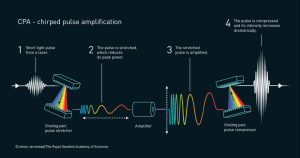Chad Orzel in Forbes:
 The 2018 Nobel Prize in Physics was announced this morning “for groundbreaking inventions in the field of laser physics.” This is really two half-prizes, though: one to Arthur Ashkin for the development of “optical tweezers” that use laser light to move small objects around, and the other to Gérard Mourou and Donna Strickland for the development of techniques to make ultra-short, ultra-intense laser pulses. These are both eminently Nobel-worthy, but really aren’t all that closely related, so I’m going to split talking about them into two separate posts; this first one will deal with the Mourou and Strickland half, because I suspect it’s the less immediately comprehensible of the two, and thus probably needs more unpacking.
The 2018 Nobel Prize in Physics was announced this morning “for groundbreaking inventions in the field of laser physics.” This is really two half-prizes, though: one to Arthur Ashkin for the development of “optical tweezers” that use laser light to move small objects around, and the other to Gérard Mourou and Donna Strickland for the development of techniques to make ultra-short, ultra-intense laser pulses. These are both eminently Nobel-worthy, but really aren’t all that closely related, so I’m going to split talking about them into two separate posts; this first one will deal with the Mourou and Strickland half, because I suspect it’s the less immediately comprehensible of the two, and thus probably needs more unpacking.
What Mourou and Strickland did was to develop a method for boosting the intensity and reducing the duration of pulses from a pulsed laser. This plays a key role in all manner of techniques that need really high intensity light, from eye surgery to laser-based acceleration of charged particles (sometimes touted as a tool for next-generation particle accelerators), or really fast pulses of light such as recent experiments looking at how long it takes to knock an electron out of a molecule. This kind of enabling of other science is exactly the kind of thing that the Nobel Prize ought to recognize and support, so I think this is a great choice for a prize.
More here.
